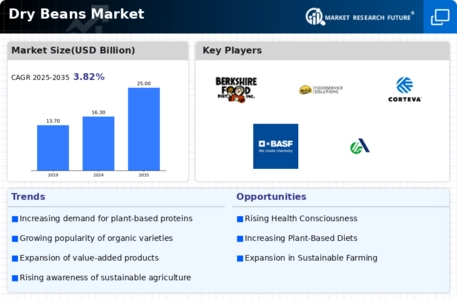Economic Viability of Dry Beans
The economic viability of dry beans is a crucial driver for the Dry Beans Market. With rising food prices, consumers are increasingly seeking cost-effective sources of nutrition. Dry beans are not only affordable but also have a long shelf life, making them an attractive option for budget-conscious households. According to recent agricultural reports, the average price of dry beans has remained stable, providing a reliable food source for many. Additionally, the cultivation of dry beans requires fewer resources compared to other crops, which may encourage farmers to invest in their production. This economic aspect could lead to an expansion in the Dry Beans Market, as both consumers and producers recognize the financial benefits associated with dry beans.
Culinary Versatility of Dry Beans
The culinary versatility of dry beans significantly contributes to the growth of the Dry Beans Market. Dry beans can be incorporated into a wide array of dishes, ranging from soups and stews to salads and side dishes. This adaptability appeals to a broad audience, including those who enjoy experimenting with different cuisines. Recent surveys indicate that a growing number of consumers are exploring plant-based recipes, further driving the demand for dry beans. As culinary trends evolve, the Dry Beans Market is likely to benefit from innovative recipes and cooking methods that highlight the unique flavors and textures of various bean varieties. This trend may also encourage food manufacturers to develop new products featuring dry beans, thereby expanding market opportunities.
Nutritional Benefits of Dry Beans
The Dry Beans Market is experiencing a surge in demand due to the increasing awareness of the nutritional benefits associated with dry beans. Rich in protein, fiber, and essential vitamins, dry beans serve as a vital component of a balanced diet. Recent data indicates that dry beans contain approximately 15 grams of protein per cooked cup, making them an excellent alternative to meat. This nutritional profile appeals to health-conscious consumers and those seeking plant-based protein sources. As dietary preferences shift towards healthier options, the Dry Beans Market is likely to see sustained growth. Furthermore, the versatility of dry beans in various cuisines enhances their appeal, potentially leading to increased consumption across diverse demographics.
Growing Interest in Ethnic Cuisines
The growing interest in ethnic cuisines is a notable driver for the Dry Beans Market. As consumers become more adventurous in their culinary choices, they are increasingly exploring traditional dishes that feature dry beans. Various cultures around the world utilize dry beans in their cuisines, from Mexican refried beans to Indian dal. This trend is supported by the rise of multicultural cooking shows and food blogs that promote diverse recipes. Recent market analyses indicate that the demand for ethnic foods is on the rise, which could lead to increased consumption of dry beans. As the Dry Beans Market adapts to these changing preferences, it may see a diversification of products that cater to the tastes of a broader audience.
Sustainability and Environmental Impact
Sustainability concerns are increasingly influencing consumer choices, thereby impacting the Dry Beans Market. Dry beans are known for their low environmental footprint compared to animal-based protein sources. They require less water and land for cultivation, making them a more sustainable option for environmentally conscious consumers. Recent studies suggest that incorporating more plant-based foods, including dry beans, into diets can significantly reduce greenhouse gas emissions. As awareness of climate change grows, the demand for sustainable food options is likely to rise, positioning dry beans as a favorable choice. This shift towards sustainability may drive innovation within the Dry Beans Market, as producers seek to enhance the environmental benefits of dry bean cultivation.

















Leave a Comment